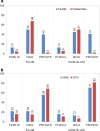Reducing Inequity in Urban Health: Have the Intra-urban Differentials in Reproductive Health Service Utilization and Child Nutritional Outcome Narrowed in Bangladesh?
- PMID: 30159634
- PMCID: PMC6458191
- DOI: 10.1007/s11524-018-0307-x
Reducing Inequity in Urban Health: Have the Intra-urban Differentials in Reproductive Health Service Utilization and Child Nutritional Outcome Narrowed in Bangladesh?
Abstract
Bangladesh is undergoing a rapid urbanization process. About one-third of the population of major cities in the country live in slums, which are areas that exhibit pronounced concentrations of factors that negatively affect health and nutrition. People living in slums face greater challenge to improve their health than other parts of the country, which fuels the growing intra-urban health inequities. Two rounds of the Bangladesh Urban Health Survey (UHS), conducted in 2013 and 2006, were designed to examine the reproductive health status and service utilization between slum and non-slum residents. We applied an adaptation of the difference-in-differences (DID) model to pooled data from the 2006 and 2013 UHS rounds to examine changes over time in intra-urban differences between slums and non-slums in key health outcomes and service utilization and to identify the factors associated with the reduction in intra-urban gaps. In terms of change in intra-urban differentials during 2006-2013, DID regression analysis estimated that the gap between slums and non-slums for skilled birth attendant (SBA) during delivery significantly decreased. DID regression analysis also estimated that the gap between slums and non-slums for use of modern contraceptives among currently married women also narrowed significantly, and the gap reversed in favor of slums. However, the DID estimates indicate a small but not statistically significant reduction in the gap between slums and non-slums for child nutritional status. Results from extended DID regression model indicate that availability of community health workers in urban areas appears to have played a significant role in reducing the gap in SBA. The urban population in Bangladesh is expected to grow rapidly in the coming decades. Wide disparities between urban slums and non-slums can potentially push country performance off track during the post-2015 era, unless the specific health needs of the expanding slum communities are addressed. To our knowledge, this is the first systematic explanation and quantification of the role of various factors for improving intra-urban health equity in Bangladesh using nationally representative data. The findings provide a strong rationale for continuing and expanding community-based reproductive health services in urban areas by the NGOs with a focus on slum populations.
Keywords: Bangladesh; Child nutrition; Community health worker; Family planning; Health equity; Maternal health; Slum; Urban health.
Figures




Similar articles
-
Effects of individual, household and community characteristics on child nutritional status in the slums of urban Bangladesh.Arch Public Health. 2017 Feb 20;75:9. doi: 10.1186/s13690-017-0176-x. eCollection 2017. Arch Public Health. 2017. PMID: 28239459 Free PMC article.
-
Progress in the utilization of antenatal and delivery care services in Bangladesh: where does the equity gap lie?BMC Pregnancy Childbirth. 2016 Jul 29;16(1):200. doi: 10.1186/s12884-016-0970-4. BMC Pregnancy Childbirth. 2016. PMID: 27473150 Free PMC article.
-
Disparities in the use of mobile phone for seeking childbirth services among women in the urban areas: Bangladesh Urban Health Survey.BMC Med Inform Decis Mak. 2017 Dec 29;17(1):182. doi: 10.1186/s12911-017-0578-2. BMC Med Inform Decis Mak. 2017. PMID: 29284477 Free PMC article.
-
Family planning for urban slums in low- and middle-income countries: a scoping review of interventions/service delivery models and their impact.Int J Equity Health. 2021 Aug 19;20(1):186. doi: 10.1186/s12939-021-01518-y. Int J Equity Health. 2021. PMID: 34412647 Free PMC article.
-
The economics of healthcare access: a scoping review on the economic impact of healthcare access for vulnerable urban populations in low- and middle-income countries.Int J Equity Health. 2022 Dec 31;21(1):191. doi: 10.1186/s12939-022-01804-3. Int J Equity Health. 2022. PMID: 36585704 Free PMC article.
Cited by
-
Quality of Care in Family Planning Services: Differences Between Formal and Informal Settlements of Kira Municipality, Uganda.Front Glob Womens Health. 2021 Aug 13;2:656616. doi: 10.3389/fgwh.2021.656616. eCollection 2021. Front Glob Womens Health. 2021. PMID: 34816214 Free PMC article.
-
Understanding urban inequalities in children's linear growth outcomes: a trend and decomposition analysis of 39,049 children in Bangladesh (2000-2018).BMC Public Health. 2021 Nov 30;21(1):2192. doi: 10.1186/s12889-021-12181-x. BMC Public Health. 2021. PMID: 34847918 Free PMC article.
-
Health Inequalities in Rural and Urban Bangladesh: The Implications of Digital Health.Mayo Clin Proc Digit Health. 2023 May 25;1(2):201-202. doi: 10.1016/j.mcpdig.2023.04.003. eCollection 2023 Jun. Mayo Clin Proc Digit Health. 2023. PMID: 40206725 Free PMC article. No abstract available.
-
Community health workers and health equity in low- and middle-income countries: systematic review and recommendations for policy and practice.Int J Equity Health. 2022 Apr 11;21(1):49. doi: 10.1186/s12939-021-01615-y. Int J Equity Health. 2022. PMID: 35410258 Free PMC article.
-
Trends and Inequalities in Maternal and Newborn Health Services for Unplanned Settlements of Lusaka City, Zambia.J Urban Health. 2024 Nov;101(Suppl 1):125-137. doi: 10.1007/s11524-024-00837-z. Epub 2024 Mar 8. J Urban Health. 2024. PMID: 38459401 Free PMC article.
References
-
- United Nations. World urbanization prospects: the 2014 revision. New York: Department of Economic and Social Affairs, Population Division; 2014.
-
- Bangladesh Planning Commission. Millennium Development Goals: Bangladesh progress report 2015. Dhaka: Government of Bangladesh. p. 2015.
-
- Banks N, Roy M, Hulme D. Neglecting the urban poor in Bangladesh: research, policy and action in the context of climate change. Environ Urban. 2011;23(2):487–502.
-
- UN-Habitat. The bad news: the locus of poverty is shifting to cities. http://mirror.unhabitat.org/documents/media_centre/APMC/THE%20BAD%20NEWS.... Accessed 30 June 2016.
-
- Muggah R. Researching the urban dilemma: urbanization, poverty and violence. Ottawa, Ontario: International Development Research Centre; 2012.
Publication types
MeSH terms
Grants and funding
LinkOut - more resources
Full Text Sources
Other Literature Sources
Medical
Miscellaneous

